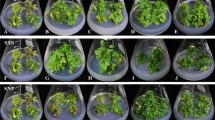Abstract
Leaves ofPelargonium domesticum andRuscus hypoglossum infected byBotrytis cinerea Pers., produced 12 and 1.5 nl ethylene/h/g, respectively, 34 days after inoculation; wounded or healthy leaves and phyloclades of them produced much lower amounts. When the fungus was grown on dead leaves it produced negligible amounts of the gas even when supplemented with methionine. Exogenous ethylene enhanced gray mold development in both hosts. Silver thiosulfate, aminooxyacetic acid (AOA) and aminoethoxyvinylglycine significantly inhibited disease development in pelargonium, and the latter two compounds inhibited ethylene production. AOA inhibited disease development and ethylene production in cut rose flowers; calcium ions inhibited disease development whereas the chelator EGTA [ethylene glycol bis-(β-aminoethyl ether)N,N,N′,N′-tetraacetic acid] enhanced it. Disease suppression by an excess of Ca2+ was correlated with repression of ethylene production by the flowers, whereas deficiency in Ca2+ increased disease severity.
Similar content being viewed by others
References
Bateman, D.F. and Lumsden, R.D.(1965) Relation of calcium content and nature of the pectic substances in bean hypocotyls of different ages to susceptibility to an isolate ofRhizoctonia solani.Phytopathology 55:734–738.
Bradford, K.J. and Yang, S.F. (1980) Stress-induced ethylene production in the ethylene-requiring tomato diagotropica.Pl. Physiol. 65:327–330.
Cohen, R., Riov, J., Lisker, N. and Katan, J. (1986) Involvement of ethylene in herbicide-induced resistance toFusarium oxysporum f. sp.melonis. Phytopathology 78:1281–1285.
Corden, M.E.(1965) Influence of calcium nutrition on Fusarium wilt of tomato and polygalacturonase activity.Phytopathology 55:22–24.
El-Kazzez, M.K., Sammer, N.F. and Kader, A.A. (1983) Ethylene effect onin vitro and invivo growth of certain postharvest fruit-infecting fungi.Phytopathology 73:998–1001.
Geeson, J.D., Browne, K.M. and Gauraldi, F. (1986) The effect of ethylene concentration in controlled atmosphere storage of tomatoes.Ann. appl. Biol. 108:605–610.
Goodman, R.N., Kiraly, Z. and Wood, K.R. [Eds.] (1986) Growth regulator metabolism.in: The Biochemistry and Physiology of Plant Diseases. pp. 245-286. University of Missouri Press, Columbia, MO.
Muchovej, J.J. (1980) Suppression of anthracnose of soybean by calcium.Pl. Dis. 64:1088–1089.
Pegg, C.F. (1984) The role of growth regulators in plant disease.in: Wood, R.K.S. and Jellis, C.J. [Eds.] Plant Diseases: Infection, Damage and Loss. Blackwell Scientific Publications, Oxford. pp. 2948.
Pooviah, B.W. and Leopold, A.C. (1976) Deferral of leaf senescence with calcium.Pl. Physiol. 52:236–239.
Reuveni, R., Perl, M. and Rotem, J. (1976) Inhibition of shedding of pepper leaves infected with powdery mildew(Leveillula taurica) by application of auxins.Phytoparasitica 4:197–199.
Reyes, R.A. and Smith, R.B.(1986) Controlled atmosphere effects on the pathogenicity of fungi on celery and the growthof Botrytis cinerea.HortScience 21:1162–1167.
Spiegel, Y., Netzer, D. and Kafkafi, U. (1987) The role of calcium nutrition in Fusarium wilt syndrome in muskmelon.Phytopath. Z. 118:220–226.
Stall, R.E. (1963) Effects of lime on incidence of Botrytis gray mold of tomato.Phytopathology 53:149–151.
Stall, R.E., Hortenstine, C.C. and IIey, J.R. (1965) Incidence of Botrytis gray mold of tomato in relation to a calcium phosphorus balance.Phytopathology 55:447–449.
Wiese, M.V. and DeVay, J.E. (1970) Growth regulator changes in cotton associated with defoliation caused byVerticillium albo-atrum. Pl. Physiol. 45:304–309.
Wurzer-Fassnacht, U. and Hoffmann, G.M. (1983) Ethylene formation of wheat germlings infected bySeptoria nodorum and the effect of seed dressing.Z. PflKrankh. PflSchutz 76:607–611.
Yu, Y.B. and Yang, S.F. (1980) Biosynthesis of wound ethylene.Pl. Physiol. 66:281–285.
Additional information
Publication of the Agricultural Research Organization. No. 2413-E, 1988 series.
Rights and permissions
About this article
Cite this article
Elad, Y., Volpin, H. The involvement of ethylene and calcium in gray mold of pelargonium, ruscus, and rose plants. Phytoparasitica 16, 119–131 (1988). https://doi.org/10.1007/BF02980466
Received:
Revised:
Issue Date:
DOI: https://doi.org/10.1007/BF02980466




